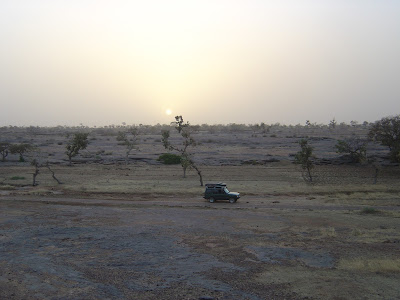If a set designer dreamed up an African village it would probably look like a Dogon village. They have a distinctive architecture that is bound to their culture and animist beliefs. Wall foundations are chunks of local sandstone, but the house and granary walls are a smooth blend of mud, straw and cow dung. The square, tall granaries are roofed in picturesque hats of straw, while the houses have flat roofs, useful for drying grains and tamarind, and for sleeping when the hot season comes (any day now).
Then there are the meeting houses, which are constructed from beautifully carved posts, and roofed with thick layers of reeds. A new layer is added for each generation. The doors and windows are also beautifully carved, and they make ladders by notching tree trunks. Many of the villages are planted on boulders on steep cliffs under an escarpment. Add to all that some of the most beautiful baobabs and fig trees, and an interesting culture, and it is not surprising that the area is the prime tourist destination in Mali, although it is quiet now. Taking photos requires a negotiation each time, which is why I don't have many.
We based ourselves in the clifftop village of Sanga, and each day drove down a steep track to explore the villages. Market days change on a 5 day cycle, but we visited two of them, always entertaining. Perhaps not so much for the goats who end up in pieces on a big wood fired grill.
Life looks hard here. Despite the tourist revenue, pumps are out of action and there is endless well work and water carrying, which is probably easy compared to the millet and sorghum pounding in big wooden pestles.
The top photo shows telem houses, at least 1000 years old, built by a pygmy people in cliff overhangs. The Dogon use them for storage and burials.









No comments:
Post a Comment